  |
| CusterMen MENU: | Italian Campaign | At The Front | Books | Armies | Maps | 85th Division | GI Biographies | Websites |
The following are a few examples
of
"Death Cards" that were printed in memory of German soldiers killed in
combat. Many religious faiths have a tradition similar to
this,
even in civilian life. Most German military "Death Cards" are
small
cards about 4 X 2 inch, printed on both sides. Usually one
side will have a photo of the deceased in uniform along with info about
him. The reverse side may have a traditional memorial scene or a
grave site scene and may include a poem. Some do not have
photos; a few will have a religious scene or message. Some Death
Cards
are printed on bi-fold card for a total of 4 pages.
For security reasons, the identity of the
soldier's unit was omitted. In most cases, the place of death was
also omitted. This type of information might allow their enemy to
determine the strength or losses of the German units. The
examples I've
selected
were of interest to me because these men served in Italy and could have
fought against my Dad. .
This page contains Death Cards for the following individuals who died in Italy:
- Pvt. Franz Dullinger - a radioman in the artillery, killed 5 September 1944.
- Lt. Karl Reuss - an artillery officer killed 30 May 1944.
- Pvt. Franz Rauch- a mountain troop, killed 9 March 1944.
- Sgt. Sigfried Ebner - Luftwaffee Field Division, killed 27 June 1944.
- Cpl. Johann Rötzer - infantryman, KIA 23 March 1944.
- Cpl. Joseph Müller - Luftwaffe FLAK Battalion, KIA 28 May 1944.
- Cpl. Joseph Guggenburger - Mountain Regiment, KIA 17 February 1945.
- Cpl. Ferdinand Zwick - Panzer Grenadier Battalion, KIA 22 September 1944.
- Pvt. Georg Ferstl - Army Artillery Battalion, KIA 11 October 1944.
- Cpl. Hans Kandlbinder - Luftwaffe Medic, KIA 26 June 1943.
The "Death Card" of Pvt. Franz Dullinger is a typical example of a death card. It is printed on a small 4-1/2 X 2-3/4 inch paper, front and back, with a small photo on the front and a religious symbol on the reverse. This example was selected because he was a radio operator in an Artillery Regiment. His job may have been similar to my Dad's; i.e. he probably operated the radio to direct artillery fire. He was a decorated soldier who was killed in action on September 5, 1944, during the heavy fighting at the Gothic Line. Private Dullinger is the oldest soldier shown on this page. He was buried in Pomezia, Block 23, Grave 20.
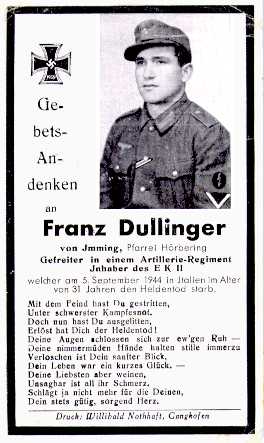 |
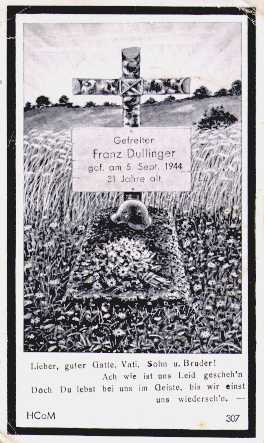 |
Prayer Rememberance of |
{ Grave Marker
} {Translation of Poem } How severely we're suffering. But you live near us by the spirit, until once we'll meet again ! Photo shows him dressed in an Army uniform and an M-43 cap, with the chevron rank of a Private First Class. Also on his left sleeve, he wears a specialty patch of a lightning bolt designating a radio operator. In the button hole of his tunic is the ribbon for his Iron Cross 2nd Class.  |
This "Death Card" of Lt. Karl Reuss is not exactly typical as it does not have a photo and is printed on one side on plain paper. The fold in the paper is noticeable. I obtained this one because he was German artillery officer in Italy and he was killed in May of 1944, when my Dad first entered combat. This 24-year old Officer earned the Iron Cross 1st Class and 2nd Class, and a wound medal, as well as a campaign medal for fighting in Russia. He definately had combat experience. It would be interesting to know the identify of his unit and exactly where in Italy he served in relation to where my Dad was located. He was buried in Pomezia, Block Q, Grave 398.
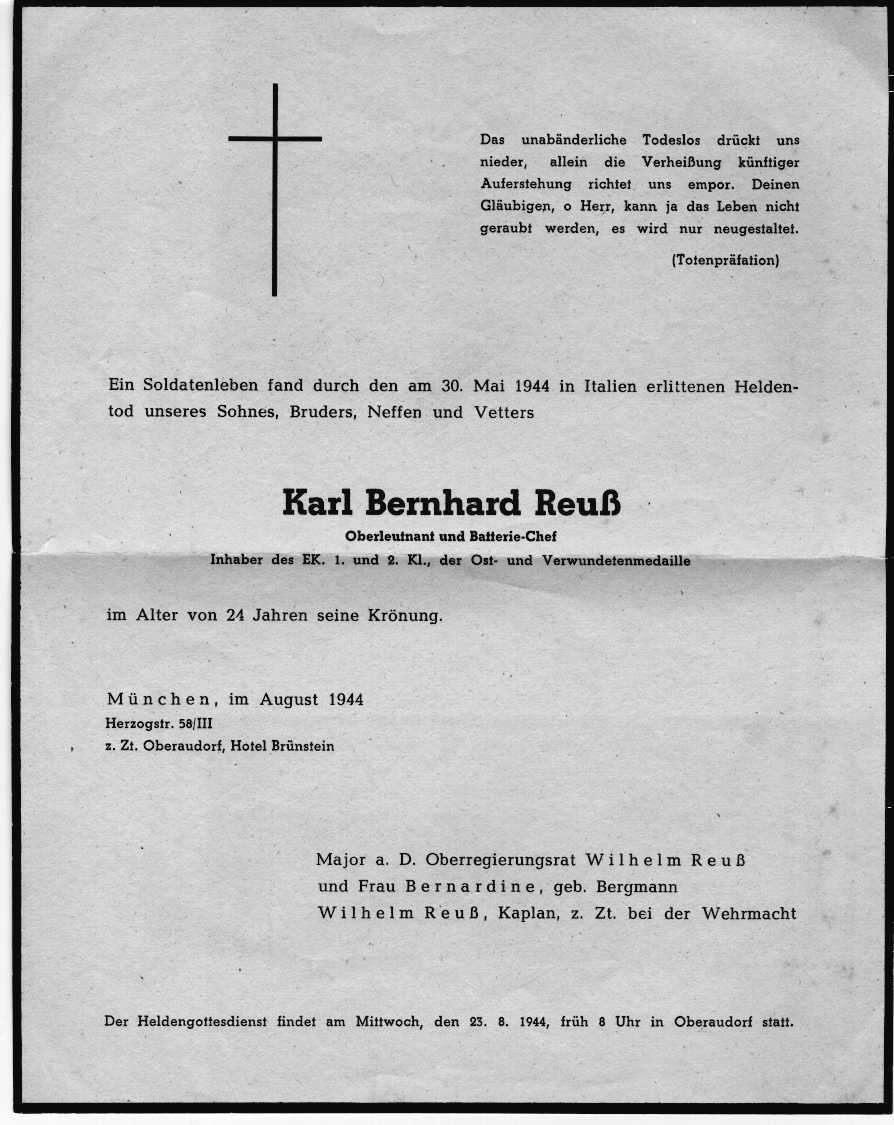 |
|
{ Poem in Old
German}
The unavoidable fate of death presses us
down,
only the hope of coming resurrection lifts us up. For the ones, who believe in you, oh Lord, life can never be robbed, it will be only transformed.
Karl Bernhard Reuss
at the age of 24 years of its coronation Munich, in August 1944
Major retired, upper government advice Wilhelm Reuss
The
hero's
service takes place on Wednesday, 23 of August 1944, at 8 Ur in
Oberaudorf. |
Franz Rauch was a member of the Mountain Division. There were several German mountain regiments and a mountain corps in Italy. The American mountain troops finally saw combat when the US 10th Mountain Division arrived in February 1945. Franz Rauch held the rank of Stabsgefreiter in a mountain regiment. His experience included the campaigns in Poland, France, Greece, Russia, and Italy. He was the holder of many awards. He was killed in action on March 9, 1944, at age 28, near Alvito, Italy. Cemetery records indicate his date of death is off by 3 weeks and he was buried in Pomezia, Block D, Grave 439.
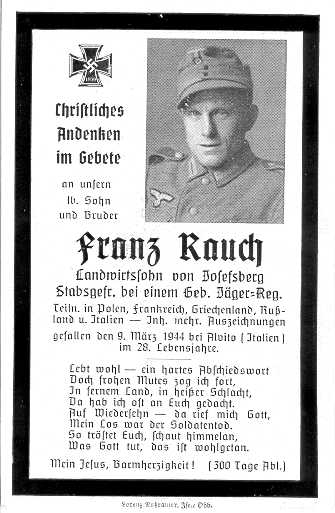 |
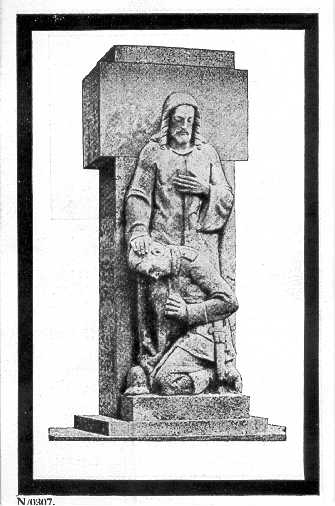 |
Christian Prayer of Rememberance |
{ Translation
of
Back side }
{Statue of Jesus praying for a kneeling soldier.}
Photo shows the deceased dressed in an Army uniform and an M-43 cap. |
Unterofficer Siegfried Ebner was a member of the Luftwaffee Field Division, which was an infantry unit that was part of the air force. He died on 27 June 1944, during the difficult campaign in Italy, after 1 ½ years faithful soldierly duty. Age; 19 years, 8 months. (Cemetery records show that his date of death was January 27.) This card is different in that his photo is on the back. His death occurred soon after the Allies captured Rome.
During June and July, the Germans fought a delaying action to hold back the advance of the US 5th Army and the British 8th Armies, so the Germans could fall back to their next defensive position on the Arno River. One source says the 19th Luftwaffe Field Division took a stand at Cecina, just north of Rome on the western coast, and fought until their unit was killed or captured.
See a description of the Luftwaffee Field Division at Luftwaffe Ground Troops. . There are two soldiers of the same name, rank and age who are buried at Cassino.
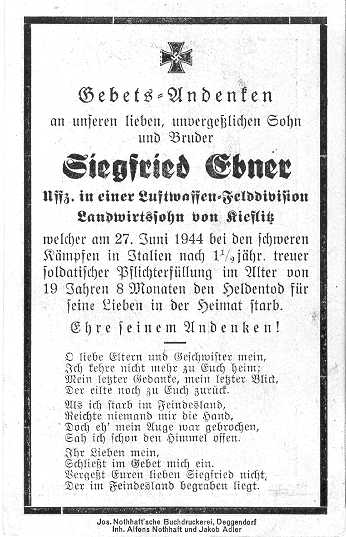 |
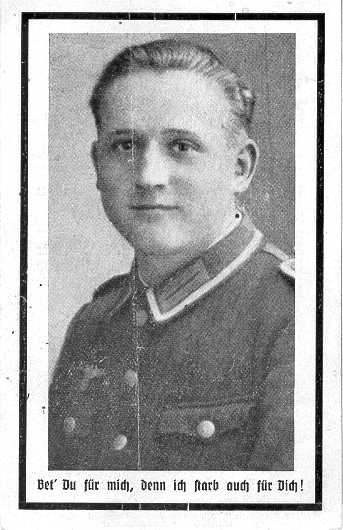 |
Memorial Prayers of |
{Unusual for photo to fill one side of the card}
Photo shows him dressed in an Army uniform with the white trim on the collar and epaulets, signifying the rank of a non-commissioned officer. Officers and NCO for the Luftwaffe Field Division came from the Army. That is probably why he is wearing an Army uniform even though he was assigned to a Luftwaffe unit. |
Obergefreiter Johann Rötzer served in a Grenadier Regiment as an infantryman--I thought it was time I included a regular soldier. His decorations included the Iron Cross 2nd Class, the Eastern service medal, the Wound Badge, and the Infantry Assault Badge. He was born on 1 August 1915 and heroically died for the fatherland on March 23, 1944 at age 28. The card states that he died in "Italy (Velledei)". I'm not sure if that is a town or not. There is a town of similar name just south of Rome. He was buried in Pomezia, Block J, Grave 420.
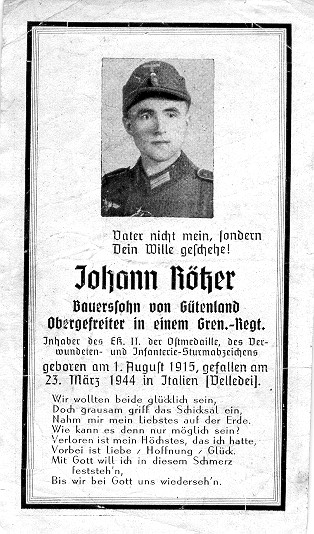 |
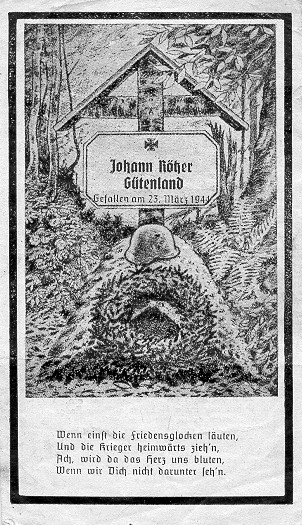 |
Prayer Rememberance of |
with Poem}
Photo shows him wearing an M-43 cap. Wehrmacht (Army) eagle on hat and right breast pocket. |
Joseph Muller was a Obergefreiter(corporal) in a FLAK Battalion serving in Italy. He was the holder of various awards. The large photo in uniform wearing peaked Luftwaffe hat. The photo was touched up to highlight the details of his uniform. He was killed in action on 23 May, 1944, at age 23. He was buried in Pomezia, Block L, Grave 549.
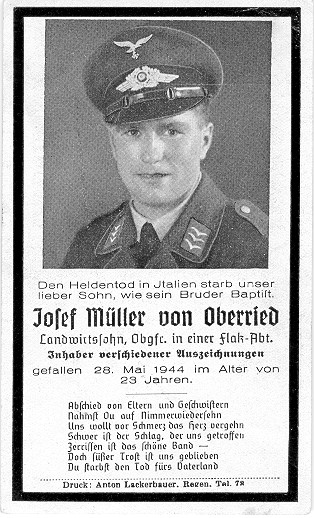 |
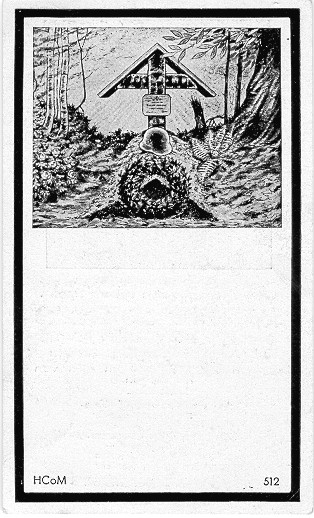 |
Killed in Action in Italy, our good son, as our brother |
{Blank - no poem}
Photo shows him dressed in an Luftwaffe uniform and peaked visor cap. The Luftwaffe cap insignia was the cockade & wreath with the addition of "wings". The Luftwaffe used a unique eagle device and small eagles on their collar rank insignia. 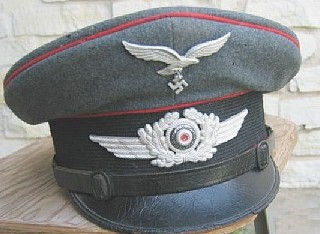 Luftwaffe NCO cap. Red piping for FLAK battery. |
Obergefreiter Joseph Guggenberger served in a Mountain Regiment. He was injured in an air attack on 17 February, 1945, and died in a field hospital the next day. He was buried in Costermano(Verona), Block 4, Grave 130.
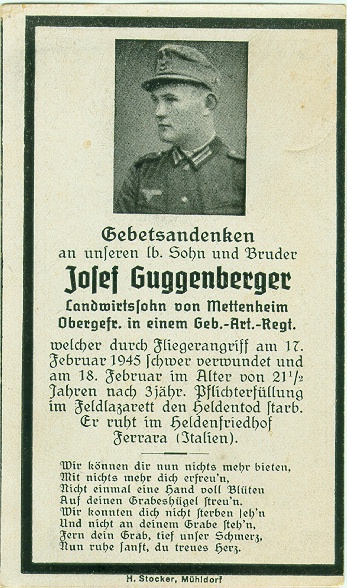 |
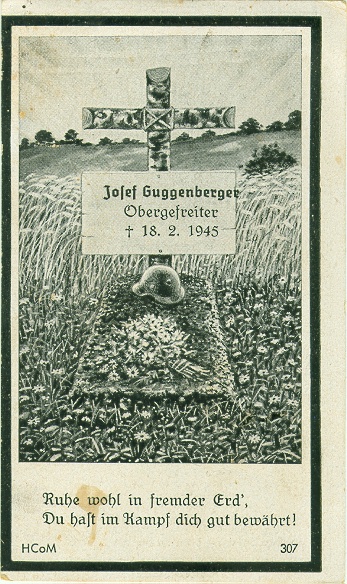 |
Prayer Rememberance of son and brother |
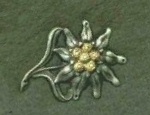 |
Three NEW cards recently acquired. Each of these cards are one sheet, printed on both sides.
Grenadier Pvt. Ferdinand Zwick died at the end of the year in 1944. This was after the Fall campaign at the GOTHIC Line and could have occurred during the German counter-attack against the 92nd Infantry Division at that time. Corporal Zwick is buried at the Cemetery at Futa Pass in Block 30, Grave 323.
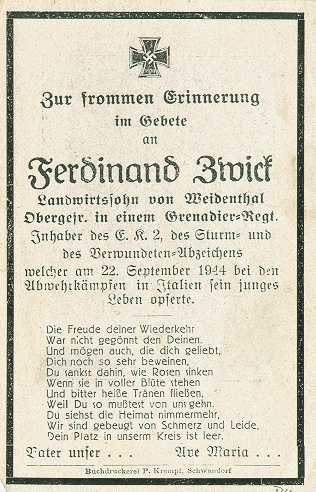 |
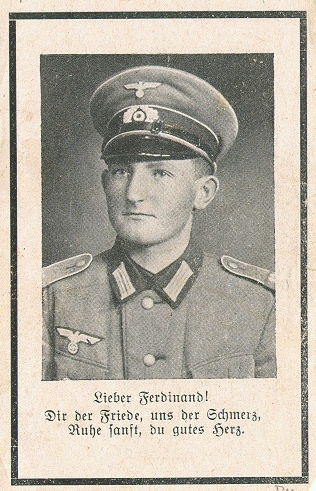 |
In devoted rememberance in honor of Photo shows Ferdinand wearing an Army uniform and a visor cap with buckles on the chin strap. |
{ PHOTO}
{Translation
of Poem on Front }
The joy of your return You sank there, as roses sink When they are in bloom and bitter hot tears fly. Because you had to go for us You see your homeland nevermore We bend from aches and pains Your place in our circle is empty. Father our … Ave
Maria
|
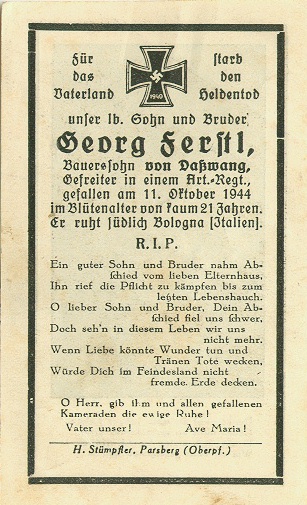 |
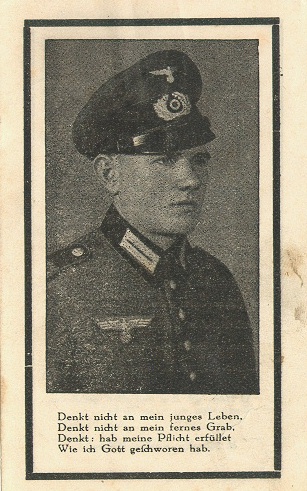 |
For the fatherland Died a hero’s death Photo shows Georg wearing an Army uniform and a visor cap. |
{ PHOTO
} {Translation of Poem on Front } A good son and brother said farewell |
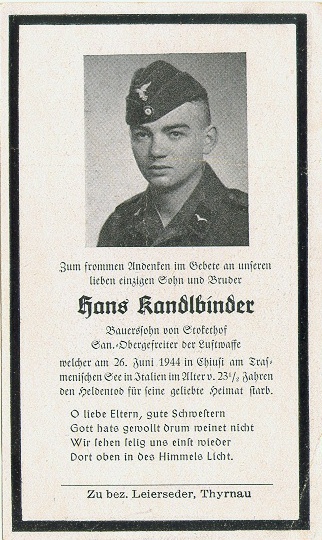 |
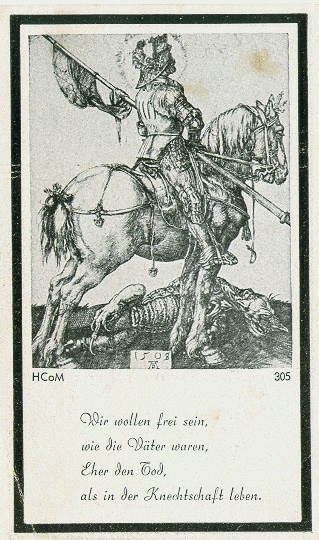 |
To the devoted memory in honor of our only |
Photo shows Hans wearing a Luftwaffe uniform with a side cap. His rank depicted here is a private. |
Research on the above CardsA special thanks to Luca Di Mascio, who is researching the Cassino battles. Di Mascio is from the UK but was born near Cassino. He researched the names on the above cards at the German war graves commission files (Volksbundes Deutsche Kriegsgräberfürsorge). He was able to confirm every name and that most of these buried in Pomezia, just south of Rome.
Franz Rauch's date of death is 3 weeks off what is written on the card. Buried in Pomezia, Block D Grab 439.
Johann Kötzer should be Johann Rötzer. Buried in Pomezia, Block J Grab 420.
Josef Müller is buried in Pomezia, Block L Grab 549.
Karl Reuss is buried in Pomezia, Block Q Grab 398.
Franz Dullinger is buried in Pomezia, Block 23 Grab 20.
Joseph Guggenberger is buried in Costermano(Verona), Block 4 Grave 130.
The entire database only lists 4 soldiers called Siegfried Ebner as having died in WW2 and amazingly two of them are buried at Cassino, and are of the same rank and similar age! The date is off by 6 months; it should be January 27, 1944. One of the two Ebner's is buried in Pomezia, Block 24 Grab 257. More research is needed on him.
German Terms:
EK - Ekin Cross = Iron Cross.
EK II - Ekin Cross II = Iron Cross 2nd Class medal worn hung from a ribbon or a ribbon inserted through button hole of tunic.
EK I - Ekin Cross = 1st Class medal that pinned on the pocket.
Ost - East = Eastern(Russian) Front Campaign medal.
Gefreiter - Private First Class in Army (each branch had different terms for same rank)
OberGefreiter - Corporal
Jahre - years Jahren - years of age
Gebets Andeken - Memorial Prayers
R.I.P. - abbreviated Latin phrase "requiescat in pace", which translates to "may he rest in peace".
Thanks, Emilie
of
Key Largo and Marcus
and Tom for the cards.
Return to Top of Page
- Return
See the German Photos discovered in a camera liberated by Sgt. Cole.
Also, more photos of German soldiers at Luftwaffe Ground Troops. Includes a color photo of a paratrooper.
German Units includes organizational tables of the German army and a table of rank equivalents to US ranks.
Return to The
Italian Campaign
or Site
Map